Syberia – Remastered review
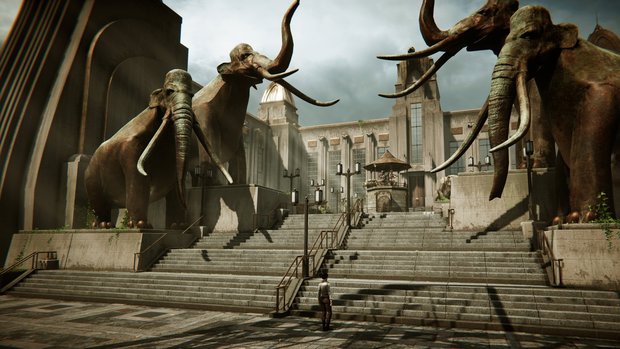
- 1 Comment
Updated remake of 2002 Benoît Sokal classic often excels but a few missteps leave it a little short of surpassing the original
In 2002, adventure fans were treated to an instant classic with Benoît Sokal’s Syberia. It was then that Kate Walker – a career-minded American lawyer – first embarked on a journey through remote and rundown European locations to discover her own inner adventurer. Set in a world of clockwork contraptions and cities of faded glory populated by an eclectic cast of human and mechanical characters alike, Syberia would go on to be followed by three more installments. Now Virtuallyz Gaming, in partnership with Microids, has gone back to where it all began with Syberia – Remastered. A mostly glorious new coat of paint has been added to the timeless story, though it does come at a cost, with the removal of certain elements and some obvious signs of that new paint already peeling.
Kate’s journey begins in Valadilene, an odd, quaint European town whose great claim to fame are its many Voralberg automatons. She is there to finalize a sale, transferring ownership of the family-run Voralberg factory to a big American toy company. However, she arrives just in time to see the funeral procession of Anna Voralberg, the woman who was supposed to sign the contract. In short order, Kate learns of Anna’s ingenious but emotionally childlike inventor brother Hans, who is set to inherit the factory and so ruin the deal. Complicating matters further, decades earlier Hans set out on a trek across Europe in search of mammoths – an obsession he held since his childhood – and hasn’t returned to Valadilene since. To track down the Voralberg heir, Kate must board a marvelous, Hans-designed train, driven by the automaton Oscar on a journey that becomes one of self-discovery along the way.
From the quaint industrial town of Valadilene, Kate’s adventure takes her to a variety of fascinating destinations. Barrockstadt is a grand old university whose entrance is presided over by a quartet of mammoth statues and whose train station is a vibrant, well-kept conservatory/aviary. Komkolzgrad is a dingy, coal-stained pit mine of a place, with harsh reds and a choking atmosphere. Aralbad was once a high-class spa retreat for the rich and famous back in the day; now it is a shadow of its past self, though its former glory still peeks out from beneath a layer of age and snow. Each of these unique settings was impressive in the original release and has become even more so with the new remaster.
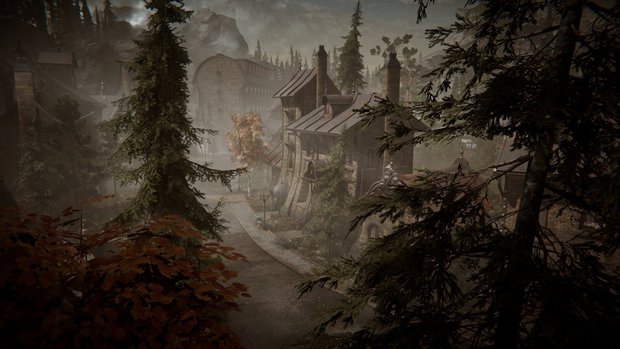
When Syberia first launched, real-time 3D graphics hadn’t advanced enough to offer the level of detail that adventure fans demanded. The compromise was 800x600 pre-rendered backgrounds with 3D characters inserted into them. Now every location has been lovingly rebuilt and presented in full real-time 3D with a level of detail that gamers could only dream of twenty odd years ago. Every cobble of every street, every leaf of every flower, is now on display and the world is just beautiful to walk through. While the backgrounds in the original game were mostly static, there is some life here: water burbles by in a stream, thick banks of clouds drift by overhead, and a gentle snowfall descends to the ground.
BUT…
Characters too have been rebuilt and detailed to a higher degree than they were previously. All are faithful to their original designs – except for Kate Walker herself. Kate has received a makeover that gives her a more generic facial appearance than she had before. Where the Kate of old was instantly recognizable, new Kate could be any of dozens of game heroines or, more likely, background characters.
Nowhere is the increase in character detail more apparent than during dialogs. Here the camera moves in on the speakers instead of retaining the fixed, distant views of the original. Still, it’s not all gold and glory here. Little has been done by way of proper lip synch, with characters only vaguely opening and closing their mouths in time with their words, and with no facial expression changes to speak of. Add to that their rather lifeless eyes and a tendency of the camera to switch to views of unrelated environmental objects, such as a desk or a glowing lamp, and these conversations can actually pull you out of the experience. It’s a shame, as it’s in the dialog with the game’s eccentric cast that the original Syberia found much of its charm.
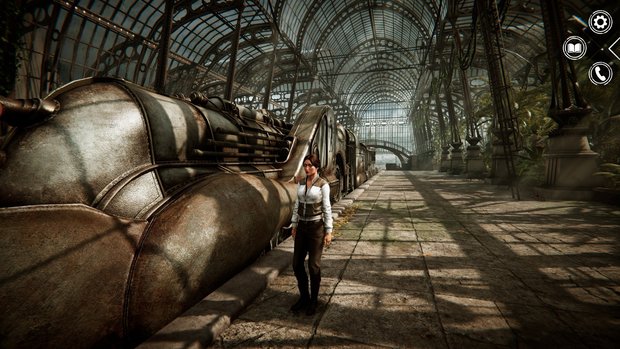
While the engine-based environments and characters have an impressive array of detail, they stand in sharp contrast to the various cinematic cutscenes. In the original game, whenever a significant story moment occurred, Syberia would switch to a full-motion video presentation as a reward for reaching certain milestones. At the time, this was a common way of providing more dynamic views at a higher graphical fidelity, and this game’s were often stunning. The great train would go steaming through the night, and Kate would watch little marionettes dance upon an intricately carved music box, among many other wonderful scenes.
Sadly, this is the area where the remaster falls shortest. Instead of recreating these sequences in the game engine itself, the old 2002 videos have been retained and merely upscaled. Sometimes they’re presented to fit the 16:9 aspect ratio of many modern monitors, while other times they’re displayed in a pillarboxed 4:3 ratio. The original videos were rendered in 16-bit colour instead of 32, and that limitation too has been retained here. This results in large colour banding and other graphical artifacts that are all the more noticeable on today’s large monitors. It’s also here that one of the most significant visual discrepancies can be seen. Whenever Kate features in these cinematics it’s the classic version of her, who looks nothing like the Kate seen elsewhere in the game.
While Kate may look different, thankfully she sounds exactly the same as the original game’s audio files have been retained. That means all of the voices in the remaster are still excellent. From the officious rectors of Barrockstadt University to the powerful pipes of a retired opera singer, all are laced with character and pleasing to listen to. Sharon Mann in particular deserves a shout-out for creating such a sympathetic character in Kate Walker. Kate grows in strength and confidence through her ordeals and is played with a deft touch, offering both tenderness and a hard attitude as the situation demands. Sometimes the situation calls for both in almost the same sentence as Kate deals with Oscar, the automaton train driver who is part butler, part bureaucrat, and always quick with an excuse as to why he can’t leave the train to help Kate. Oscar can be annoying, but he is a great foil for Kate, and he remains oblivious to the frustrations Kate airs on behalf of the player.
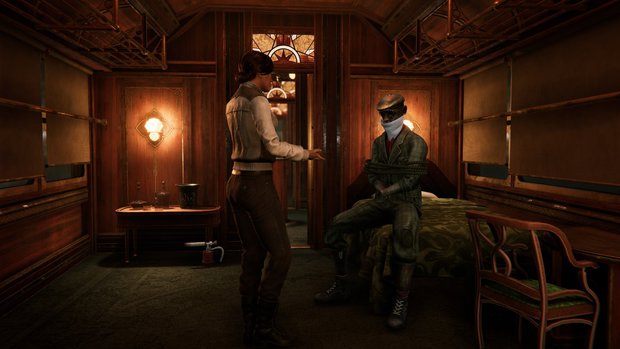
In preparation for the remaster, I replayed the original Syberia first. I couldn’t tell any difference in the technical quality of the audio recordings themselves, as they sounded quite good back in the day and equally so now. However, as with the changes to Kate’s character model, such back-to-back playthroughs did reveal that the new version is not a completely faithful overhaul of the original. Some dialog lines and indeed entire scenes have now been cut.
Once I’d witnessed enough of these cuts, I noticed a pattern begin to emerge. While much splendid work has been done on the (non-Kate) character models and locations, the same cannot be said for the character animations. The original game boasted motion capture animation, providing Kate and the other denizens of the world with very smooth and natural movements. The remaster starts with a decent amount of animation, with the manager of the Valadilene hotel helping Kate with her luggage, but increasingly it omits all but the most story-critical animations as it goes along.
New Kate no longer opens doors. She no longer walks up stairs, preferring to glide while her legs move in her standard walking animation. At several points the removal of animations is quite jarring, as they used to serve as a natural transition from one location to the next, which is now left to a hard cut instead, such as when Kate extends a ladder and then magically appears at the top without being shown to have climbed it. It should be noted, however, that since so many modern games do this, all but a handful of missing animations would be largely unremarkable had this been a completely new game. It’s only in the shadow of the original that the remaster is found particularly wanting in this regard.
That trend extends to the game’s puzzles as well. Syberia was never a difficult game to begin with, as it focused more on story and character in its eight-hour play time, but the remaster has been simplified even more. Irrelevant hotspots have been removed from the game environments. Mostly this is a good thing, as many of them are those doors that players of the original may remember – and grumbled about – as places Kate would run to only to say that she couldn’t open them. But even puzzles have been removed entirely, perhaps due to the aforementioned animation restrictions. For instance, getting the young boy Momo to help Kate dam up a river is now completely absent from the game.
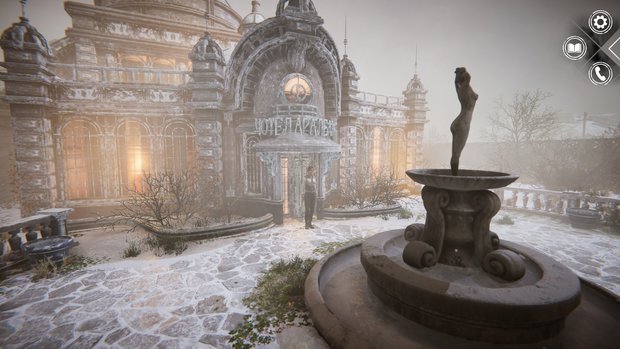
Oddly, some new puzzles have been added in their place, such as reconstructing a piece of chime sheet music instead of simply using a pre-recorded music cylinder. Such puzzles are done in close-up views and all are mechanical in nature. However, since only the game’s original voice lines are used, Kate offers no commentary or insight, so these become just “things to do” instead of adding anything meaningful to the tale.
The story itself remains intact, of course. While a few lines and scenes have been omitted that longtime fans will remember, the main plot and character moments remain. Trepidatious at first, as Kate journeys across the continent, she learns how capable – and how fearless – she can be. This is punctuated by the phone calls she receives from home. Her fiancé Dan, best friend Olivia, boss, and mother all frequently call her to see how she’s doing. At first she’s very involved in these conversations, but as she broadens her horizons, the people back home and their petty concerns become of less importance to her. All of this culminates in Kate’s final stop. For those who remember the closing moments of the original, the remaster still tugs at the heartstrings. The conclusion (if not closure) to the story is still as beautiful and moving as it was in 2002.
In both versions, emotion is at the heart of the Syberia experience, helped greatly by its musical score. It is a signature of Benoît Sokal’s games that they all have a melancholy core. A wistfulness for days gone by and the sights of faded glory. These themes are transcribed into every melody within the game, brought forth accurately in the remaster from the original release. There is adventure, tenderness, tension, and sadness in these tunes; sometimes all at the same time. The only issue with the new version is that the default sound settings aren’t balanced too well, with the music tending to drown out the dialog. However, some quick adjustments in the game options will quickly deal with this issue.
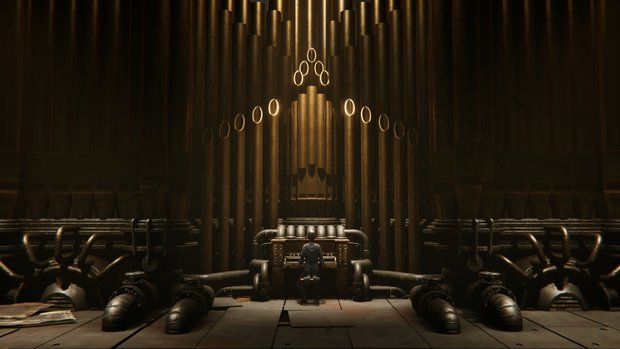
On the control front, games have evolved since 2002 and the remaster has fallen in line. It still presents a point-and-click control option but now adds controller support as well. Either method works fine for moving Kate around and both keep players more occupied than in the original game. Back then, clicking was the only option and Kate had some distant locations to get to with a fair bit of non-interactive space in between, meaning a lot of pointing-and-waiting. Those lengthy jaunts are still present but for longer stretches you can now optionally hold the mouse button down instead of repeatedly clicking to keep guiding Kate along.
In a concession to being in a full 3D environment, as Kate moves through the world, white dots are overlaid to show points of interest depending on how close she is to them. These white dots must be clicked upon directly instead of being able to click anywhere on the corresponding hotspot, which is a little inconvenient at times. The presence of the white dots, and a larger white overlay in the top-right corner of the screen to access the game menu, inventory, and Kate’s cell phone, clashes stylistically with the more natural environs of the scene itself, rather like a spray of graffiti over a fine painting.
Dialogs are also presented in similarly high-contrast white text atop the game backgrounds instead of the more naturally fitting notebook format of the original game. (Another discrepancy that wouldn’t seem as noticeable if this game were a brand new release.) For those looking to rush through conversation, dialogs have been streamlined with the presence of an exclamation mark for topics that are critical to progress, and those without being merely for flavour. However, it’s in the latter that much of the game’s character can be found. Whether it’s the Valadilene innkeeper, who insists on using the term automaton instead of robot even though he himself doesn’t know the difference; a grouchy, non-English speaking sailor who has to communicate with Kate through his even grouchier wife; or an opera obsessed miner who’s gone a bit squirrelly from being on his own for too long, there are a lot of quirky personalities to be found and enjoyed.
Supposedly streamlining things further is the ability to choose between “Story” mode and “Adventure” mode, but as far as I could tell, the former only adds a list of outstanding tasks to Kate’s in-game journal, providing gentle clues that prompt you toward what to work on. One last adjustment to the game options is worth calling out. When starting the remaster you are given the choice of three save slots, but progress throughout the game is automatically recorded and you’re unable to create your own saves. Making the best of a bad situation, the game at least performs an autosave every time you change location. So, if you need to take a break from playing, find the closest doorway to go through before you exit. It’s workable, but given that the original allowed free saves anywhere, it’s one more place where the remaster doesn’t quite measure up.
Final Verdict
Syberia – Remastered is a visual sight to behold – at least most of the time. It has marvelously realized locations and characters that add a new level of detail and clarity to Sokal’s unique vision. Add to that the same heartfelt journey for Kate Walker as before and if this is your first experience with the game that started the franchise, it is one definitely worth playing. However, this recommendation becomes less certain for anyone who played and has fond memories of the original. That game was rightfully considered a classic work of art, and aside from the in-engine graphic enhancement, the remaster is at best on par with the original and in many ways not quite to the same standard. While I certainly don’t regret having played the remaster, given the choice I would prefer the classic, even with its lower-resolution graphics, simply for getting all the ingredients more exquisitely balanced. Either way, original or remaster, Syberia’s imaginative world, characters and story stand the test of time and I will always welcome the opportunity to take one more train ride with the brilliant Kate Walker.
Hot take
An upgrade in some ways and a step back in others, the remastered Syberia doesn’t quite measure up to the classic work of art that was the original, but its melancholic trip through an entropic Europe filled with automatons is still splendid enough to delight new players to the franchise.
Pros
- Highly detailed updated environments
- Hauntingly beautiful music
- Excellent original voice acting retained
- Fantastic character journey for protagonist Kate Walker
Cons
- Inconsistent visual styles
- Removal of certain content and animation
- Lack of proper save system
Richard played Syberia – Remastered on PC using a review code provided by the game's publisher.


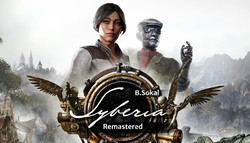








1 Comment
Want to join the discussion? Leave a comment as guest, sign in or register.
Excellent review, thank you. I will always be frustrated but thankful with the Syberia saga - the first game felt like a third person adventure changed mid dev to a third person one as someone (successfully) noticed that it could ride on the tails of "The Longest Journey". There were loads of empty rooms and loads of animations where I could only see Kate Walker walking and showing that a$$. Indeed you could see it more often than her face or her expressions. I never like when a game try to be highbrow with really overdone cultural references so the operatic part felt a bit embarrasing to me (it was a thing with Sokal, he loved to make the references very explicit so they could be approachable by the greater number of people, or so I noticed once I had the chance to interview him). But the build up to the end got me, and I was really devastated when the game ended, so the surreal journey on the sequel got to me. It was a couple of games I tried to hate as they were far away from the kind of adventures I grew up with (way less serious, more cartoonish) and because they reflected the 00s edginess of brown/mute colours, sunsets and the very superficially lyrical themes (the sunset! see the sunset? it is a symbol of dying! you did not get that did you?) but it got me, and I give it to it. Now, on the remake: I know that remakes of classic adventures where they change the puzzles can be a complete success (Riven) or a disaster (Broken Sword DC) with the dialogue and puzzle decisions, and this one looks more like the second one. What I really hated, not hyperbolically, hated about the Amerzone remake was the overdone sunset bloom effect and it seems they softened it a bit here. Anyway, will play it eventually.
Reply
Leave a comment